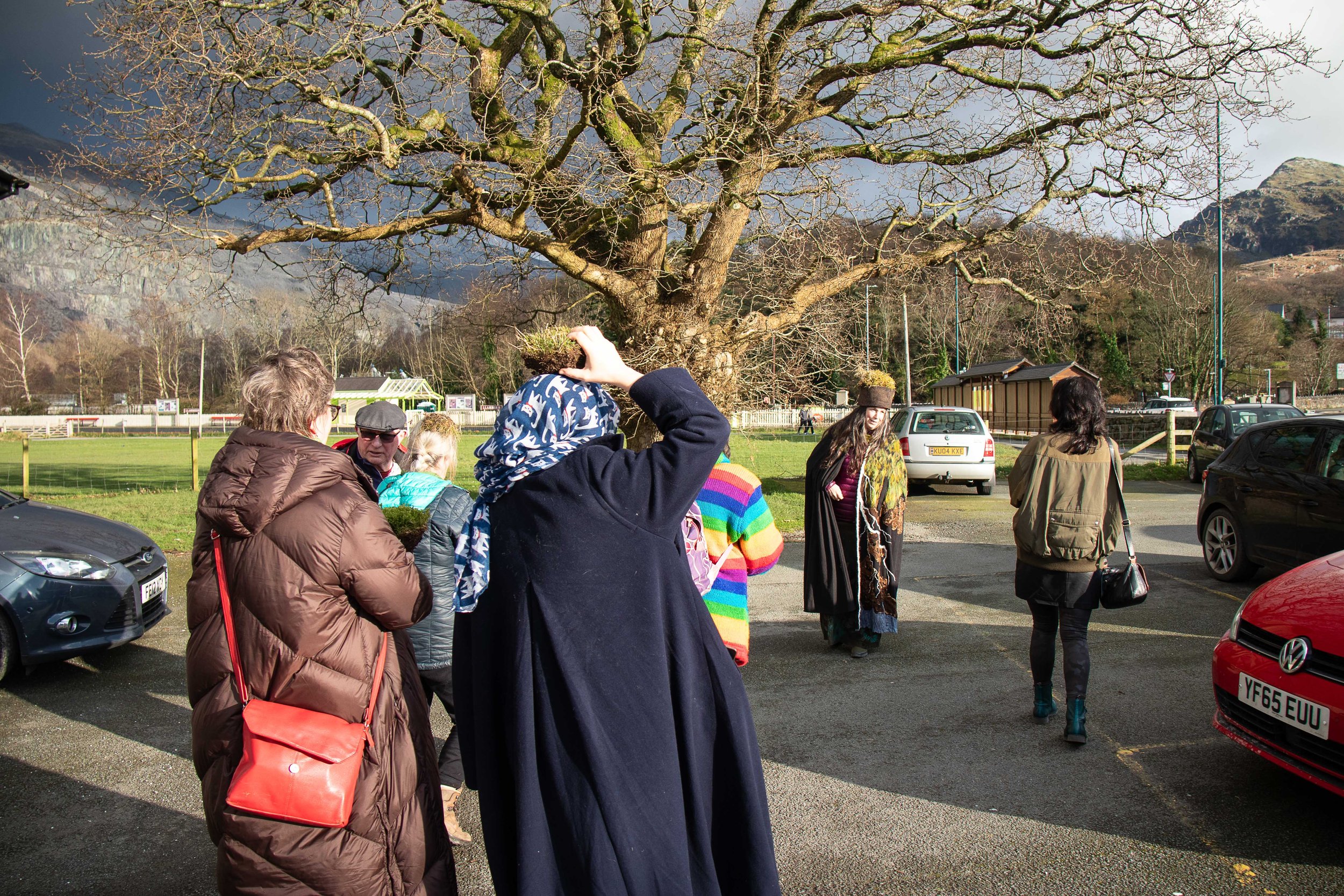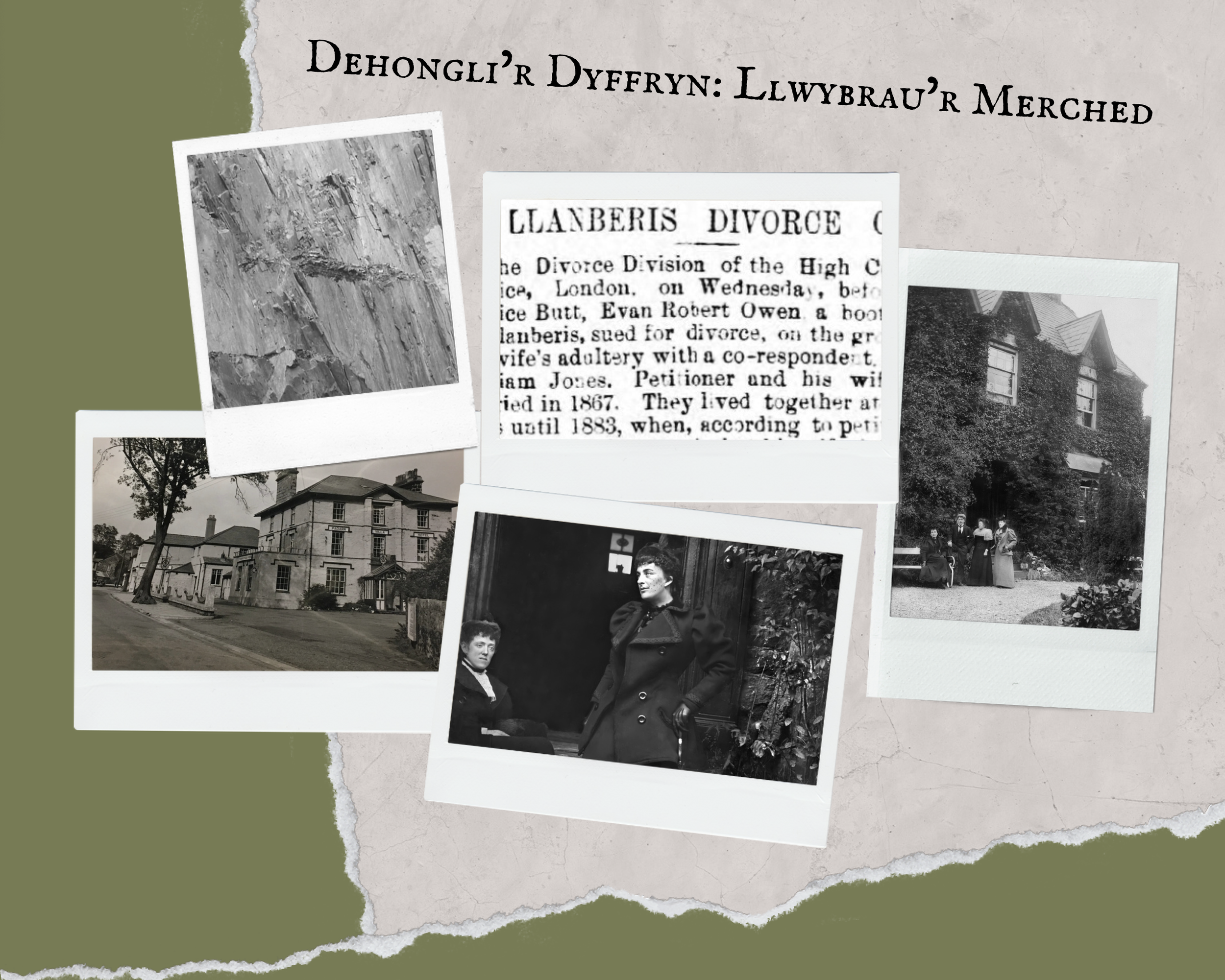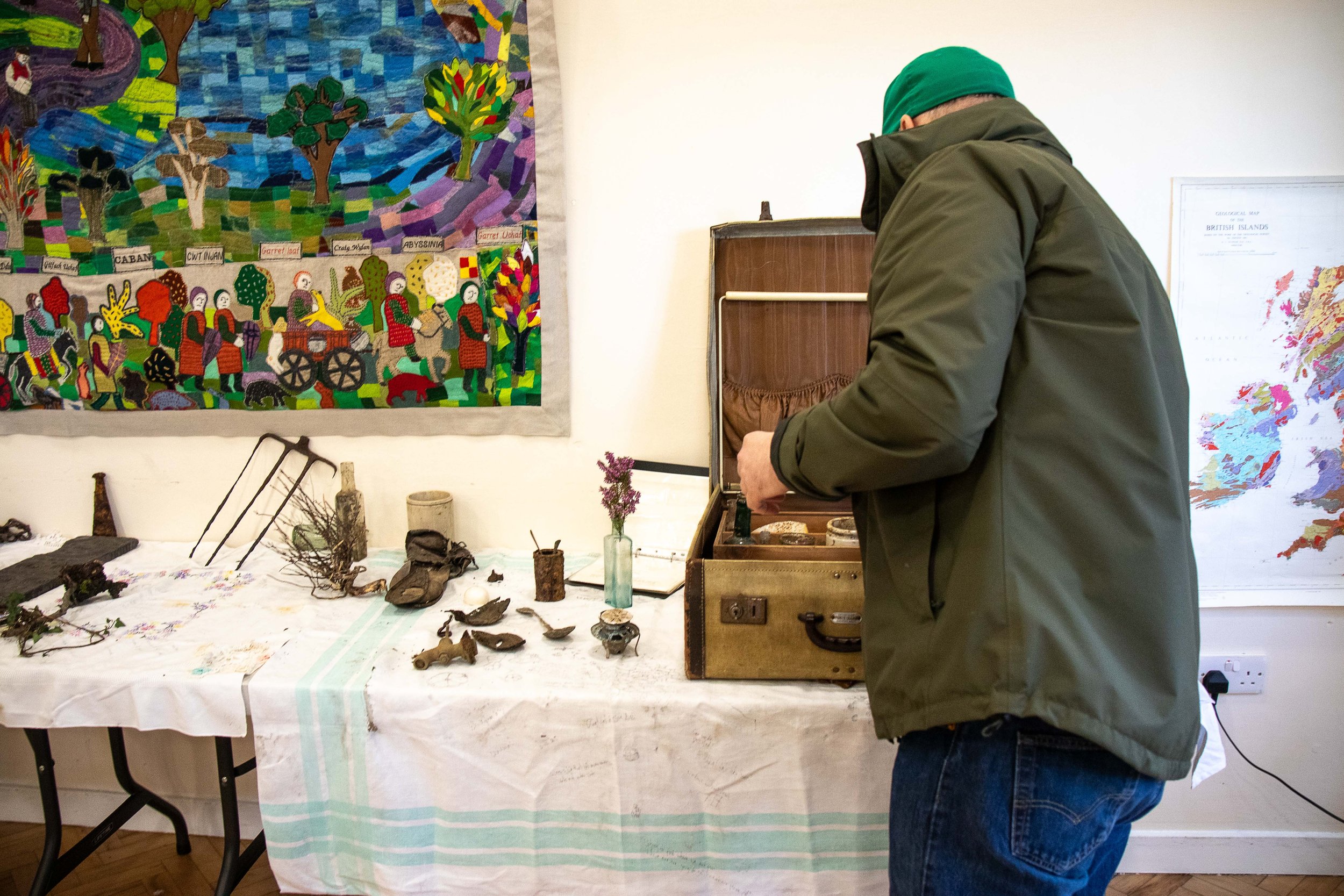

Chwedlau’r Tir Dyffryn Peris Legends of the Land
Sant Peris, Rhita Gawr, Cerrig Arthur, Canthrig Bwt, Igyn Gawr, Cawres Peris, Tylwyth Teg,
Llechi Llyfnion, Padell y Brain, Cwm Dwythwch, Carreg Noddyn, Moel Eilio……
Mae prosiect Chwedlau’r Tir Dyffryn Peris (rhan o Stori’r Tir Dyffryn Peris) yn eich gwahodd i ymuno â ni i archwilio beth mae’r straeon hyn am le yn ei ddweud wrthym am y gorffennol, y presennol a’r dyfodol… a sut y gallem ail-ddychmygu ac ailadrodd y straeon?
Rydym yn eich gwahodd i geisio ail-ddelweddu / ailadrodd chwedl Dyffryn Peris (gweler yn isod) … mewn geiriau, delweddau, sain, fideo....
Dyffryn Peris Legends of the Land project (part of Stori’r Tir Dyffryn Peris) invites you to join us in exploring what do these stories of place tell us about the past, present and future… and how could we re-imagine and retell the stories?
We invite you to try re-imagining / retelling a Dyffryn Peris legend (see below)… in words, images, sound, video…
Rhowch wybod i ni beth rydych chi’n ei wneud/sut mae pethau’n mynd trwy e-bostio Storirtir@gmail.com
Let us know what you are doing/how you are getting on by emailing Storirtir@gmail.com
Beth ydy’r chwedlau’r tir Dyffryn Peris?
I ffindio allan, mi gaethon ni sgwrs gan Dafydd Whiteside-Thomas efo Claire Mace a Lindsey Colbourne yn Y Ganolfan Llanberis, 5ed Mehefin 2024. Dyma sgwrs gan Dafydd (yn gymraeg)
Ychydig mwy o’r llyfr gan Dafydd:
Y Garreg Lefain – carreg ateb
Ar ystlys Cefn Du uwcben pentref Ceunant mae grwp o feini lle saif y Garreg Lefain. Dyma, yn ôl traddodiad, un o hoff fannau’r Tylwyth Teg. Me hon yn garreg adlais neu ‘garreg ateb’ a dyna sut y cafodd ei henw. Gallai fod yn safle gwylio ers talwm oherwydd o’I pen gellir gweld ar draws y dirwedd tua’r Eifl un cyferiad ac I gyffiniau Dinas Dinorwig I’r cyfeiriad arall. Gerllaw hefyd mae olion nifer o hen gytiau crynion a mwnt claddu
Y Tytlwyth Tanddaearol: “Y Nocars”
Mae’r Tylwyth hwn, sydd y tu hwnt o gyfeillgar, yn byw yng nghrombil y ddaear. Yn wahanol i’r Tylwyth Teg sydd wedi diflannu o swn a dwndwr ardaloedd diwydiannol, mae’r Tylwyth Tanddaearol I’w cael mewn pyllau glo, gweithfeydd copr a phlwm, chwareli llechi neu unrhyw gloddfeydd eraill. Yr enw cyffredin arnynt yw Nocars neu’r Cnocwyr, tylwyth hynod o ddiwyd sy’n gwybod am leoliad pob gwythïen werthfawr. Mae’n cael ei gyfrif yn hynod o lwcus I glywed y Nocars yn gweithio gan eu bod bob amser un agos at wythïen werthfawr o fwyn. Mae’r Nocars weithiau yn rhybyddio rhag peryglon o dan y ddaear. Bryd hynny mae eu cnocio a’u morthwylio yn wyllt ac anghyson.
Caer hanesion amdanynt yng ngweithfeydd copr llethrau’r Wyddfa ac yn chwareli llechi Dinorwig. Roedd yn draddodiad gan rai gweithwyr I adael rhywfaint o fwyd ar ôl dan ddaear fel I’r Nocars am unrhyw gymorth.
What are the Dyffryn Peris Legends of the land?
To find out we had a talk by Dafydd Whiteside-Thomas with Claire Mace and Lindsey Colbourne in The Community Centre, Llanberis, 5th June 2024.
English notes from Dafydd’s talk
No writtten legends - all word of mouth, like chinese whispers, forever changing.Until about 1820, Dyffryn Peris was very isolated - there was only a path to Nant Peris via Pen y Pass - the original road was Ffordd Ceunant. It was so narrow two horses couldn’t pass each other. Perhaps this is why nothing new was coming in, so the legends were kept longer. They are very old.
Travelling from the top of Dyffryn Peris…
Gorffwysfa Peris, now Pen y Pass. Here there was a huge pile of white stones. Tradition was that if travelling beyond Pen y Pass you’d walk round the pile of stones, reciting the Lord’s Prayer to get protection for your journey. You’d maybe go round 10 or 12 times if you wanted to be especially safe! [See Cawres Peris below for the legend of how the stones got there]
Canthrig Bwt, a witch, giant, sourcerer said to live under the Cromlech boulders. She stole and ate children of Nant Peris. Similar horrific stories eg the Hairman. A creature covered in hair used to steal and eat children in Nant Gwynant. At Hafod y Llan a woman on her own in a farm heard a noise and saw a hairy hand coming through the window searching for her child. She chopped the hand off with an axe, and followed the trail of blood to a cave, and sealed the creature in. Were these stories just to frighten children from wandering too far? Were these places at that time deeply forested and dangerous (wolves etc)?
Saint Peris - one of the sons of the king of legendary sunken kingdom of Cantref Gwaelod, he came to Nant Peris in 6th century [refugee from climate change?]. [The Feast Day of Saint Peris is 11th December. He had a well, Ffynnon Peris, which has a number of legends associated with it, and the church in Nant Peris is dedicated to him]
Marged Ferch (uch?) Ifan - Pont y Meibion. Strong woman, wrestler, carpenter, harpist. Used to row copper along the lake from the mine in Nant Peris all the way down to the port at Gwm y Glo, where the old school is. To build the bridge at Nant Peris, she is said to have held one end of the giant slate slab while all the men of Nant Peris were needed to hold the other. On way from Cil Fach Du to Castell Dolbadarn is a bridge made from the same piece of slate. [giant/strong women are quite a theme in Dyffryn Peris!]
Cawres Peris - giantess who lived somewhere up the pass. Every morning she would come down to wash in Llyn Peris. She was so big one foot was placed where the copper works were (where the bunk house is now) and the other at Carreg Nofyn / Llechi Llyfnion (which has disappeared under the quarry rubble). Ffos Nofyn was a deep pool of water here (changed by the hydro). Cawres Peris had a lover near Denbigh. There was a tradition that women in love would take white stones to their lovers. So she filled her apron with stones and carried them through Bwlch Llanberis to take to him. As she reached the top, her apron broke and all the stones fell to the floor. She lost her temper and left the stones there, creating a cairn of white stones. White stones are quite a common story
Cabbage and Cattle - Stories of extremes - quarrymen who travelled to the USA to work with slate used to tell tales of their homeland. They said there were storms here sometimes, but it wasn’t too bad because the cattle could shelter under the cabbages! In California a tale was told that in the summer it was so hot people in Nant would feed icecream to their chickens to stop them laying boiled eggs.
Brenhines yr Wyddfa - the queen of Snowdon - once you see her, you can’t stop seeing her
Carreg Arthur - on the side of Cefn Du, King Arthur
Carreg Badell y Brain - crow’s cauldron, Betws Garmon
Tylwyth Teg - In 1800s, William Williams said “The fairies have disappeared from the land” because non-conformist beliefs wouldn’t accept superstitions. But in 1925, a farmer saw a fairy at Carreg Lefaen near Cefn Du. Many fairy stories are connected with farms - almost every farm has a fairy story - enticed into a fairy ring, dancing, then returning to find everyone had died. Fairies went up to dance at Maen Du Arddu cliff, and the people of Nant were warned not to go there. TH Parry Williams, when asked ‘do you believe in fairies’ said "no, but they do exist” [A tree near your farm would keep fairies away - you can still see these trees eg see Y Coeden Hynaf - the Oldest Tree?]. This link between farms and the Tylwyth Teg is strong - red hair was seen as a sign that you were a descendent of a farmer/Tylwyth Teg liaison - there are records of ginger farmers quarrelling at markets being called fairy children.
Sgwrs gan Dafydd Whiteside-Thomas
Cwm Dwyiethwch - children were warned not to go there because of the Tylwyth Teg. But a boy went to the lake and saw some girls bathing there. He fell in love with one of them and realised they were Tylwyth Teg. He was told he couldn’t marry her until he discovered her name. Tried all sorts, and then hid and listened to the fairies, who called her Penelope. They married and lived on a farm on the other side of Rhyd Ddu. The only condition was he couldn’t hit her with iron, but one day he did (by accident) and she disappeared. How old is this story? Perhaps in the iron age people moved in, persecuting the original people who maybe lived here in Crannogs? So iron associated with loss of the old ways?
Cwm Ty Du - highest part on way up to Moel Eilio. Was this called something else originally? Ty Du estate 1500+.
Penllithrig y Wrach
Moel - the name of places with ‘moel’ in them refers not a lack of hair/bald (as is often said), but without a peak, smooth: in old Welsh you used to pay your taxes in goods, labour, butter, flour. When they’d pour the butter into the bowl it created a mound which would go above the side of the dish. You’d “talu heb y foel” - pay without the top of the mound, so you could slice the mound off and keep it
Lady Magician at Cwm Dwyiethwch - similar story to Cawres Peris: She had a lover in Sir Fon (Anglesey) and wanted to take stones to him. She intended to build a bridge so they could meet. She had so many white stones she sunk into the land and refused to drop her stones. Eventually she got free and went to Waunfawr where her apron string broke and she lost her stones. Two rivers meet here and formed Afon Goch: Gafl y Wyddon. Gafl = a fork. carnedd Wen - white; carnedd waun - on meadow: they used to build houses and small holdings at Ceunant using these stones.
Llanrhedu - fox called rhedu was being hunted and the fox jumped Machlyn Bach and greyhounds followed it up Carnedd y Filiast. The fox was caught - hence the name Rhedu’s leap
Are there factual causes of these stories and place names? eg:
Cadair Edyll - Elf’s Chair on 1881 map. The daughter of a couple living at Llwyn Bedw in Nant married someone from the Wyn family (Gwydyr estate)and so came into riches - did they ‘invent’ the story of Elves living in the house to keep people away?
Llyn Cwellyn - in the 4th Century Macsen Wyledig, emporer of Rome married Helen Luyddawc, the daughter of a Caernarfon based chiefan [itself a great story, with some factual basis]. Their son was travelling and was killed by Cidwm (Castell Cidwm) and buried by the shores of the lake at the bottom of the cliff. There is a field there called ‘Gweirglodd Bedd’ (the meadow of the grave) and a stone chest of bones was found here… so perhaps there is factual truth in this story
Description of Dyffryn Peris by Thomas Pennant – A Tour in Wales, 1778
“This is a very picturesque vale,
bounded by the base of Snowdon, Cefn Cwm Gafr, the two Glyders,
and two Lliders, each of them first-rate mountains.
It is strait, and of nearly an equal breadth, filled by some meadows, and two magnificent lakes, which communicate to each other by means of a river. The venerable oaks, spoken of by Leland [1536] are no more.
Avarice, or dissipation, and its constant follower, poverty, have despoiled much of our principality of its leafy beauties.
Among the numberless errors of this performance, I fear the word is IS cloathed with trees, must be supplied by the traveller with WAS.
But this shadeless tract is still worthy his attention.
A road, once a succession of rude and stony stairs, made with much labour, ran on one side, high above the lake, and was often cut out of the rock, to form the way. This is, I am now informed, changed into a road, which too much facilitates the approach, and lessens its propriety, and its agreement with the wild environs.
“In this valley are two groupes of wretched houses.
The farthest is near the upper lake, with its church, dedicated to St Peris,
who was, we are told, a cardinal.
Here is to be seen the well of the saint, inclosed with a wall.
The Sybil of the place attends, and divines your fortune by the appearance or non-appearance of a little fish,
which lurks in some of its holes.
“From hence I took a ride above the lakes, to their lower extremity.
The upper is the lesser, but much the most beautiful piece of water.
It is said to be in places a hundred and forty yards deep;
to have abounded with char,
before they were reduced by the streams flowing from the copper mines,
which had been worked on the sides of the hills.”
Thomas Pennant – A Tour in Wales, 1778
2025
Teithiau cerdded a gweithdai adrodd straeon a thynnu lluniau.
Collaborative story-telling and drawing walks and workshops.
Beth ddigwyddodd yn / What happened in 2024
19.9.24 Gweithdy Adrodd Stori’r Tir: Telling the Story of the Land Workshop efo Claire Mace
AM DDIM/FREE!
Dewch â’ch stori, neu rywfaint o ymchwil neu ddeunydd trwy brofiad yr hoffech chi ei syntheseiddio i mewn i stori. Byddwch yn dysgu offer a fydd yn eich helpu i deimlo'n fwy hyderus wrth rannu eich stori.
Bring along your story, or some research or experiential material you’d like to synthesise into a story. You'll learn tools that will help you feel more confident in sharing your story.
6.10.24 ‘Sesiwn stori agored’ ‘open story session'
Ty’n Llan/Vaynol Arms Nant Peris 5-7yh/pm
Dewch i rannu straeon, barddoniaeth, caneuon, hyd at 10 munud, sydd ag unrhyw gysylltiadau â Dyffryn Peris
Come and share stories, poetry, songs, of up to 10 mins, that have any links to Dyffryn Peris
Mae Chwedlau’r Tir rhan o’r prosiect Stori’r Tir Dyffryn Peris: Legends of the Land is part of the Stori’r Tir Dyffryn Peris project:
Amdan Stori’r Tir - About Stori’r Tir
Mae Stori’r tir yn brosiect creadigol sy’n casglu a rhannu storiau ynghylch ein perthynas gyda’r tir yn Nyffryn Peris.
Dan ni’n dod a’r gymuned at ei gilydd i gipio doethineb y cenedlaethau blaenorol, hybu hunaniaeth a chyswllt
gyda’r tir a’r iaith Gymraeg.
Stori’r Tir is a creative project gathering and sharing stories of our relationship to land in Dyffryn Peris.
We are bringing the community together to capture the wisdom of previous generations, promote identity and connection to the land, creativity and the Welsh language.
Ebost: Storirtir@gmail.com
Email: Storirtir@gmail.com














